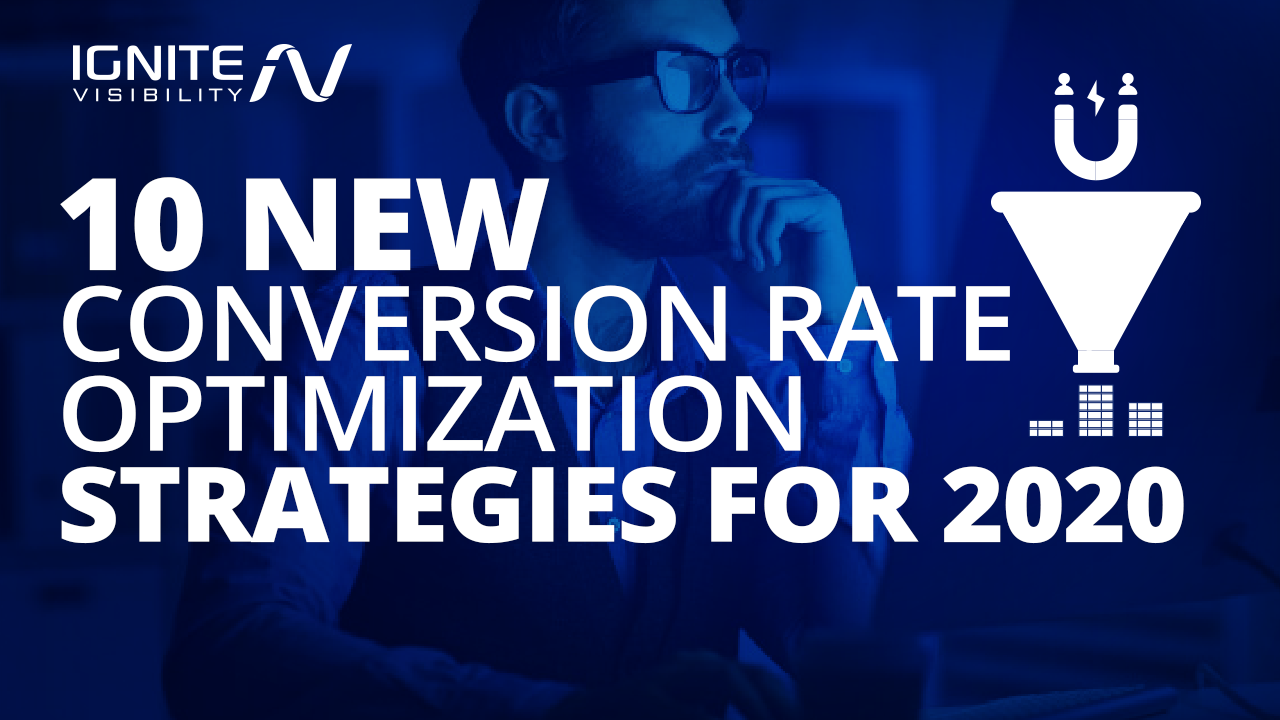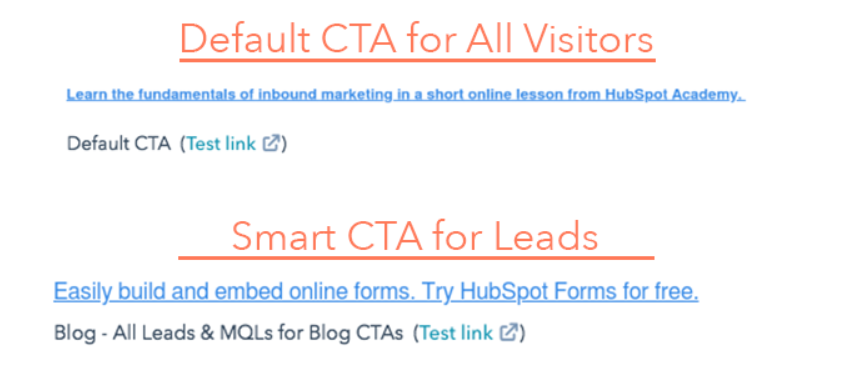Conversion rate optimization (CRO) covers the entire marketing strategy, from generating leads to improving the post-sale experience and giving your brand reputation a boost.
Whether you’re selling sneakers or SaaS solutions, CRO success hinges on setting objectives and tracking your performance.
In this article, I’ll look at ten conversion rate optimization tips to help you boost your bottom line in 2020 and beyond. Let’s dive in.
What We’ll Cover:
- Align CRO and user experience
- Optimize for different personas
- Get more strategic with CTAs
- Use the Market Basket Analysis to boost sales
- Find (and kill) your conversion killers
- Install a chatbot for improved service
- Make sure your CRO strategy accounts for new ways of searching
- Combine your CRO and SEO efforts
- Simply the decision-making process for users
- Be ready for increased privacy regulations
1. Get CRO and UX in Alignment
Over the past few years, the focus on the customer has gotten, well, obsessive.
Today, every function from CRO to SEO, customer service to the support desk and the sales team, all must work together to improve the user experience.
While user experience (UX) is more about how people feel when interacting with a brand and CRO is a structured approach to identifying and eliminating friction points throughout the customer journey, both focus on creating a simple, seamless process.
A solid CRO strategy can help you improve UX by creating a personal, relevant experience for your audience.
Here are a few of the UX basics:
Navigation: If users can’t figure out how to move through your website, they won’t hang around long. Make things easy on your users by structuring your site according to content hierarchies.
This graphic from Search Engine Journal does an excellent job breaking down how you might organize your site by moving from broad categories to niche sub-topics (and applying search terms along the way).
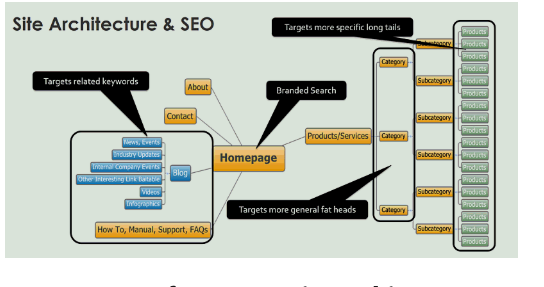
An SEO-approved way of organizing your website. Source
SEJ also addresses how to apply internal links to your pages based on their place in your “content hierarchy.” For example, product pages should link to related content like FAQs, blogs, and knowledge base entries.
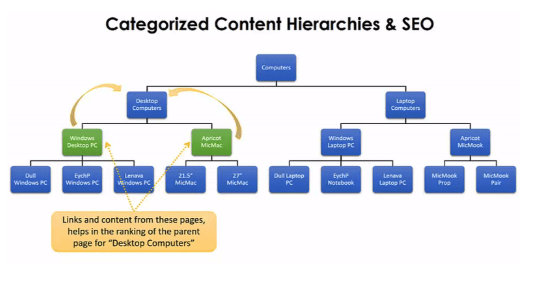
How to categorize content on your website. Source
Mobile-friendliness: Mobile-first indexing is not only a big deal for SEO, it’s also a vital piece of the UX puzzle. While mobile users are less likely to buy than their desktop counterparts, mobile devices are often used for research.
Meaning, if you fail to nail your first impression, you’ll miss out on the opportunity to convert later.
Page speed: Yes, we’re still talking page speed. Google recommends a page load in 5 seconds or less, though most pages fail to meet that mark. And, though most users claim they’ll wait 4 seconds or more before clicking away, most people bounce from a page after just 3 seconds.
Message clarity: Your text on page should always be clear and focused, and should match user expectations. For example, your description in the search results should always match the content on the page you link back to.
Embrace UX-CRO Collaboration: Collaboration will help you set more tactical goals. So, if CRO aims to reduce cart abandonment rates, consider all of the UX-focused tactics that come into play, like form size and number of external links on the page.

How to reduce shopping abandonment rates. Source
Get teams on the same page by prioritizing the following efforts:
- Organize regular meetings between UX and CRO teams.
- Involve both teams in the testing process. Apply the UX approach to CRO testing to avoid testing random ideas or basing hypotheses on best practices instead of real data.
- Work from a unified data set. While CRO and UX might apply different methods, they need to be able to view the same insights and customer records to collaborate on an effective strategy.
2. Optimize for Different Personas
According to ITSMA research, brands face a few key obstacles when it comes to building effective buyer personas.
- Not performing qualitative research with buyers.
- Focusing on demographic information over real customer insights.
- Developing personas based on things like industry, role, or interests rather than how they move through the buyer’s journey.
While that report is a few years old, it underscores the importance of researching your audience in several different ways.
In 2020, customers expect personalized solutions at every touchpoint. And, per research from Marketing Sherpa, brands that offer segment-based content stand to increase conversions by up to 97%.
When you’re working with three, four, ten different segments, you need to really dig into the data to get to know all of your users.
Get inside customers’ heads by combining different types of data for a holistic view. Here’s a look at some of the methods you might use to do this:
User surveys
If you want to know what users want, just ask. Tools like SurveyMonkey, Qualaroo, and countless others make it easy to collect feedback from visitors and loyal customers alike.
Recording tools
While numbers paint a picture of what works, tools like heat maps and screen recordings will reveal why it works. User recording tools allow you to see how visitors move through your website from their point of view.
In the example below, you’ll notice that the user struggles to move through this multi-level navigation process. Every time she finds the item she’s looking for, the whole list disappears. Viewers can witness the frustration themselves and flag that as a point of friction.
A survey, by contrast, might reveal that customers felt frustrated by the navigation, but it might not be clear why that is.
Recordings also work well for uncovering new segments. For example, you might discover patterns showing different groups interacting with your content or product pages in different ways.
These subtle differences might not be obvious in looking at your analytics or Facebook Insights, but present an opportunity to personalize your marketing materials further.
Social listening
Users tend to be very forthcoming on social media, especially if they have something negative to say. By staying in-tune with what your users post and engage with on social media, you can gain valuable insight into their pain points and triggers. Try using a dedicated social listening tool like Mention or Keyhole to keep up with the conversation.
Intent research
BERT is just the beginning. I believe we’ll soon start to see more updates that further Google’s understanding of user intent. While keyword research remains a factor, many SEOs are spending more time crafting content around intent.
Is your target query navigational? Informational? Commercial? Or does it signal the intent to “go shopping?” Understanding the terms that lead users to your site–and ultimately, drive conversions–will become an increasingly important skill.
3. Get More Strategic With Your CTAs
The old “call to action” (CTA), is a marketing standby, not a trend by any stretch of the imagination.
CTAs, of course, prompt visitors to take action and should be present on all pages.
Start by making sure you get the basics down:
- Placement: Your CTA should appear above the fold for maximum visibility.
- Color and shape: Your CTA should not blend in with your site; it should stand out with the shape and color of the button you choose so that it’s easy to catch attention.
- Make it benefit-oriented: Bland CTA copy like: “download,” “click here,” “Continue,” are boring and fail to inspire action. Instead, place the emphasis on benefits. Think: “get my report,” “stay connected,” or “Show me more.”
Beyond those basics, it pays to embrace a few new CTA strategies.
According to Hubspot, personalized CTAs convert 42% more visitors than generic ones.
Personalization has played a big part in marketing strategy for some time now, from personalized email subject lines and ad creative all the way to a website’s CTA.
Hubspot calls these Smart CTAs. Unlike your typical CTA, these are tailored to each user by their location, language, page history, etc.
Here’s an example Hubspot uses of a default CTA versus a Smart CTA created for existing leads.
4. Use the Market Basket Analysis to Boost Sales Among Existing Audiences
There’s a concept known as the Market Basket Analysis, which is a way for sellers to identify connections between the products they sell.
In a CRO context, you’d use this strategy to learn if your customer segments are likely to buy another set of products.
If we’re talking e-commerce, you might look at different categories like clothing and accessories, tents, and other types of camping equipment, and other items that complement each other.
These days, brands can use AI to identify commonly linked items, though it’s important to understand that analysis should go beyond product associations.
For example, do certain segments purchase more on a specific day? At a specific time? Are there services you offer that are commonly bundled together?
When you crack the combination code, you’ll have more opportunities to increase sales (and retention rates) among existing customers. You’ll also collect more data that can then be used to inform your next marketing efforts and drive even more conversions.
5. Find (and Kill) Your Conversion Killers
Okay, this is an unpleasant topic, but if you want to drive conversions, you need to figure out what you’re doing that drives customers away.
Here are a few common reasons that your site isn’t converting:
You’re Targeting the Wrong Traffic
If you’re talking to the wrong crowd, you’ll face some challenges when trying to convert them. Go back to your persona research and learn more about what your audience wants.
Your Brand Has Low Trust Signals
Online reputation spans everything from reviews to branding and website security. I dig into the idea of building trust more here, but you’ll need to develop a strategy around a few core areas:
- Develop a unique value proposition.
- Create helpful content that answers users’ questions and addresses pain points.
- Maintain cross-channel consistency.
- Be transparent and authentic in all brand communications.
- Use social proof such as testimonials, case studies, and reviews.
- Make sure your site is secure.
Your Internal Search is Frustrating
According to Moz research, common problems here include:
- Search box isn’t long enough.
- Search results don’t make sense.
- Search results don’t account for spelling errors, plurals, hyphens, or other potential variations.
- Search results aren’t prioritized.
Your Checkout Page is Poorly Optimized
According to research from the Baymard Institute, cart abandonment rates average around 69%. Chances are, your checkout page could benefit from a few changes.
A few ways to improve the process:
- Be transparent about shipping rates.
- Make sure your checkout page is secure.
- Make sure that your check out page matches your brand look and feel. You don’t want users to think you’ve duped them into checking out at a second location (scam).
- Optimize for mobile. Statista found that 23% of purchases are made using a mobile device.
- Add testimonials and reviews to your site.
- Make the checkout process as fast as possible. 28% of customers ditch the cart due to a long checkout process.
6. Chatbots for CRO
No longer the frustrating experience they were a few years back, businesses are increasingly using chatbots to improve the on-site experience.
Here are a few ways that a well-placed (and programmed) chatbot can improve your CRO strategy:
Faster Response Times
Because humans can’t offer real-time messaging all the time, bots are picking up the slack.
According to a study published by Drift, only about 7% of companies responded in under five minutes.
They also found that the chances of converting a visitor were 10x higher when companies responded within that crucial five-minute window. A bot can help improve your turn-around time and respond much more quickly to user inquiries.
Better Data
Account-based marketing platform providers like Drift and DemandBase are embracing this practice to boost conversions by replacing form-field landing pages.
The benefit here is that chat brings more context into the mix than static form fields.
A chatbot can further qualify leads by asking a series of questions that can help human sales teams present them with a customized solution.
Additionally, chatbots can also help uncover areas where customers get confused. Conversation logs can reveal where customers drop out of the funnel, which can help you pinpoint which pages are causing friction.
You might also add a quick poll to pages that aren’t converting to collect user feedback.
Improved Service
Chatbots allow users to bypass the FAQ page and answer questions fast.
Let’s look at Kayak’s chatbot as an example. The travel brand’s bot helps users book flights and hotel rooms and sends check-ins and reminders later in the process.
As you’ll see in the screenshot, the app also helps travelers find things to do ahead of their upcoming trip.
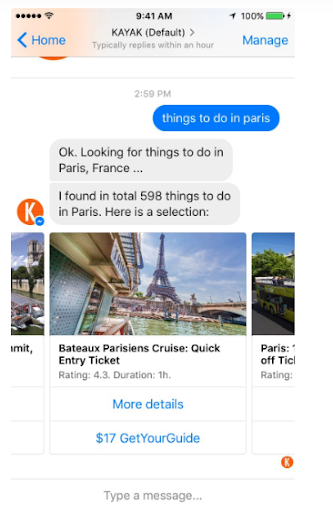
Chatbots can help improve customer service. Source
7. CRO Needs to Reflect New Ways of Searching
It’s safe to say that voice is here to stay.
According to a study by Juniper Research, the number of people using voice-based assistants like Alexa, Siri, and Google Assistant will increase by 1000% over the next five years.
So, what does this all have to do with CRO? A lot, actually.
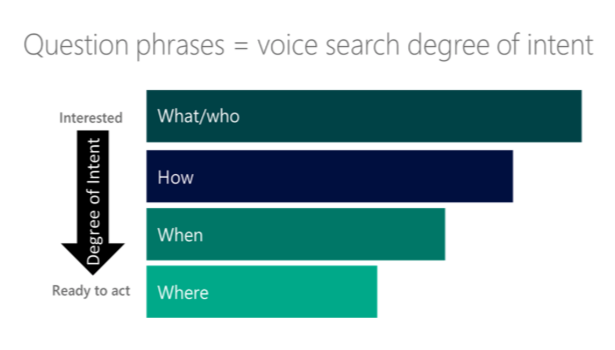
Question phrases and voice intent. Source
Here are a few things that come into play when putting together a CRO strategy:
- Write how you talk. Content should sound natural when read out loud. Optimizing for short keywords may have messed us up, and voice is fixing that problem. Today, search is more about answering questions for searchers in a clear, concise manner.
- Focus on intent. I know I keep saying this, but understanding the intent behind a search query and building content around that intent is huge here. Develop your content strategy, social posts, and PPC keyword lists around longer tail keywords to match user intent as they move through the buyer’s journey.
- Set up your schema. Applying markup to your site is also more important for driving conversions, as it increases visibility and highlights the most important on-page elements. Using schema markup helps search engines better understand intent and places content in front of the right searchers.
Additionally, those brands that pass Google Publisher standards have the option to use Speakable to markup topical news stories for voice-based delivery.
It’s important to note that voice isn’t just for performing online search queries, either.
Voice-based apps do everything from controlling your smart home devices to taking notes and guiding users through the steps of a new recipe. Brands can increase their visibility by creating their own apps–or Google Actions (and Alexa Skills)–to further connect with user interests.
8. SEO + CRO Get Closer
There’s a lot to be said about the relationship between CRO and SEO. But at the end of the day, both perform best when working toward a shared goal.
Still, sometimes SEO can efforts hurt conversion rates and vice versa. A focus solely on the bottom line can mean trouble for things like user experience and intent matching.
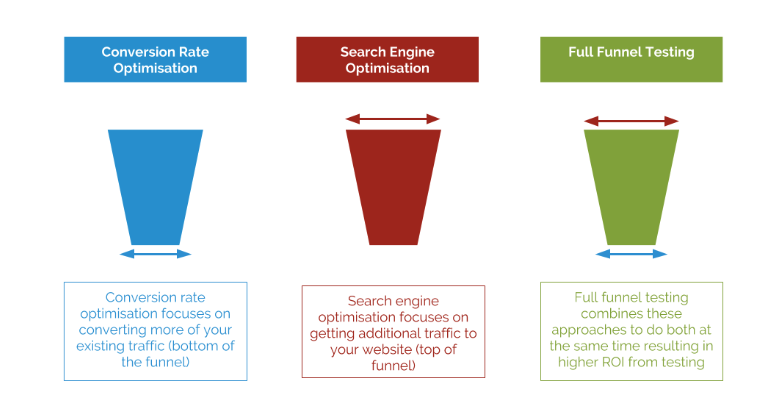
CRO and SEO can be combined for a full-funnel strategy. Source
In 2020, I predict we’ll start to see a shift toward a unified SEO and CRO strategy, as opposed to two strategies with conflicting priorities.
As Google continues to make improvements to the end-user experience, content focused on driving sales is unlikely to perform well organically.
However, brands still need to come up with new ways to drive more business and increase conversions.
Here are a few ways you can bring these two strategies together:
Combine Great Design with Powerful Stories
With SEO and social both becoming more competitive, it’s more important than ever to develop a unique brand persona across multiple channels.
When brands use the same tactics, visuals, and copycat each others’ story (which happens a lot), it comes across as mass-produced and inauthentic.
To overcome this issue while also increasing conversions, brands need to tap into their audiences’ emotions by telling great stories and offering actionable solutions.
The CRO side of the equation should focus on driving conversions through placement and formatting, not “sales words.”
This infographic below does a nice job highlighting those elements that drive conversions through visuals.
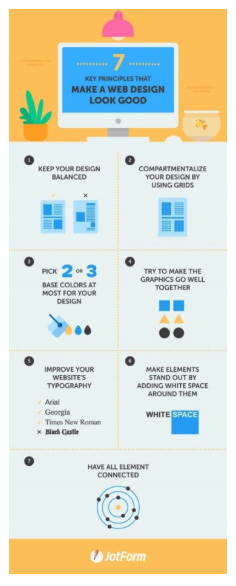
How to design a website that converts. Source
Continue to Keyword-Optimize
As mentioned above, you’ll need to make sure you have a clear understanding of your target audience and the search queries they’ll use to find your brand.
In 2020, you’ll still need to use long-tail keywords to target more specific groups on search engines.
But keep in mind, this strategy now requires brands to get serious about intent matching. Make sure you can match the intent behind each keyword to the content provided on your page.
CRO Goes Omni-Channel
Social channels like Facebook, Twitter, Instagram, and YouTube should all work together to create a connected brand image.
Increasingly, Google likes to see consistency across all of your different brand profiles and pages, so going omnichannel is great for SEO.
Luckily, it’s a great approach for CRO as well.
Communicating directly with your customers while maintaining a focus on CTAs and keywords will help you drive growth on each marketing platform and drive traffic to your site.
Additionally, an omnichannel strategy allows you to focus on building your reputation across different channels, which plays a role in convincing customers to trust you.
SEOs Need to Embrace CRO-Style Testing
CRO involves a ton of testing to help teams understand which pages are likely to drive the most conversions. While A/B testing is old news for CRO, it has yet to gain traction among SEOs.
That said, we’ll likely see more SEO-based testing as Google starts relying more heavily on artificial intelligence to rank pages.
Data sourced from A/B testing allows teams to reduce bounce rates and better engage with users coming from search engines, and thereby will likely have a big impact on SERP rankings.
9. Simplify the Decision-Making Process
More choice isn’t always a good thing. Consider how hard it is to pick a movie on Netflix or choose a product on Amazon.
While in theory, we like having all of these options at our fingertips, there’s no doubt that sifting through each and every one is a major time-waster.
Driving conversions, is in part, an exercise in efficiency.
By reducing the options available on one page, you’re reducing the time it takes for customers to make a decision.
In the 2004 book, The Paradox of Choice – Why More Is Less, psychologist Barry Schwartz writes that reducing the numberof unwanted choices can help alleviate anxiety among shoppers.
And since 2004, the sheer volume of choices we face each day has exploded.
Reducing choice is already a best practice for landing pages. However, we’re starting to see a similar approach playing out on SEO pages, homepages, and product pages to keep users focused on taking action.
On B2B pages, that might mean limiting navigation links and focusing on one offer per page.
E-commerce websites should embrace white space and stick to “Add to Cart” and “Buy Now” buttons to guide users toward completing the goal.
10. Privacy
Last but not least, today’s version of CRO needs to be ready for the increase in privacy regulations.
Between the GDPR, PECR, and the new CCPA, companies doing business in Europe, the UK, and California (aka any US company with a national audience) need to start taking data privacy and transparency more seriously.
While new rules can make life harder on marketers, the goal is all about creating a better experience for our users.
Here are a few areas you’ll need to examine if you haven’t already.
- Obtain consent where necessary. Any testing tools that store personal data do require consent, though anonymous surveys like NPS do not. You may also want to look for a solution that “buckets” data to protect your business against the threat of a data breach.
- Update your privacy policy. Let users know what “opting in” really entails. Keep in mind, even if you’re just using Google analytics, you’ll need to let customers know. Any data you collect should be used to improve the customer experience.
- Don’t focus testing on one person. Don’t combine heatmaps, scroll maps, and other user-testing tools with other data sources, particularly while looking at a single person. It’s too easy to learn WAY too much about a person by combining data sets, so you’ll want to tread carefully here. This same logic applies to super niche groups, as it’s easy to identify individuals.
- Avoid storing certain types of data. Stop collecting things like traffic location, device IDs, or other details that cross over into the personal space unless you plan on adding it to your policy.
Wrapping Up
CRO spans many different parts of the marketing process, from usability to reputation management, intent matching, and communication methods.
As with most marketing strategies today, the lines between CRO and other practices like SEO and UX are becoming increasingly blurred.
Each approach shares the same goal, creating a cohesive experience across every channel with clarity and usability at the center of every blog post, PPC ad, video, or email.
